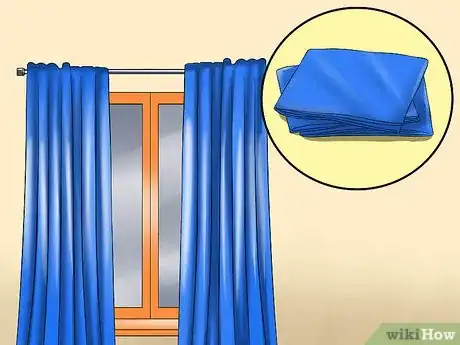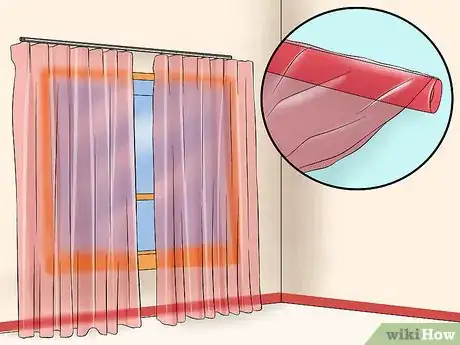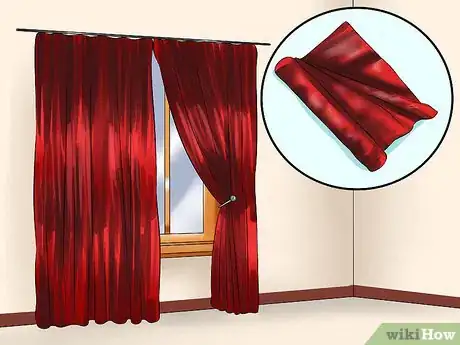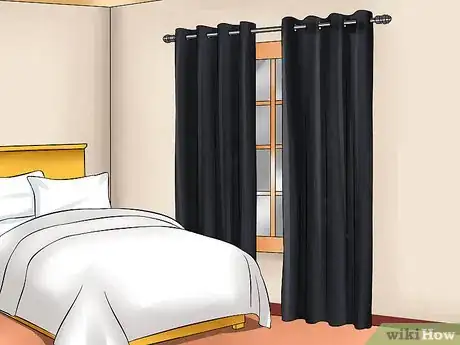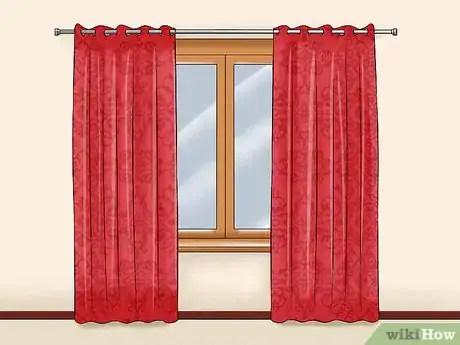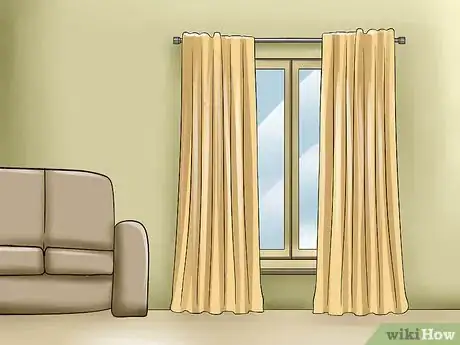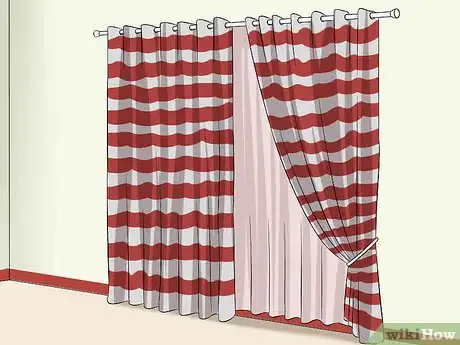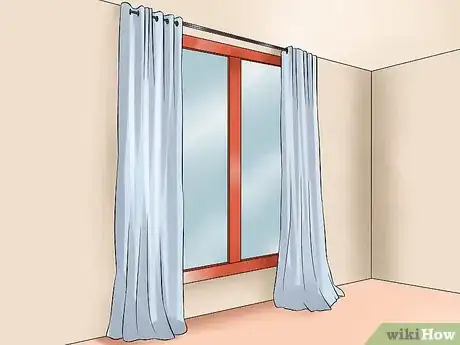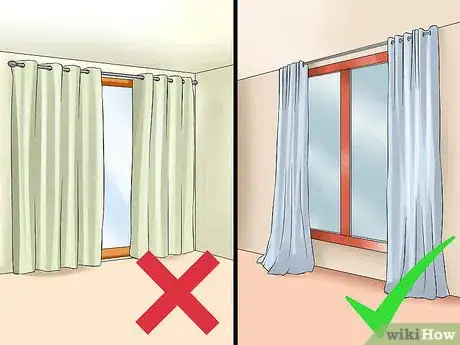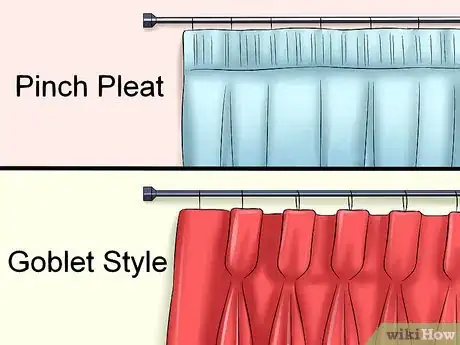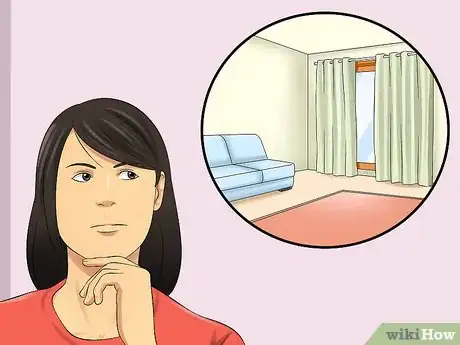This article was co-authored by Karen Parziale and by wikiHow staff writer, Amber Crain. Karen Parziale is a Home Stager, Home Organizer, and the Founder of The Real Estate Staging Studio based in Hoboken, New Jersey. Karen has over 15 years of home staging and decorating experience and has staged over 5,000 homes. She specializes in project management, space planning, material selections, and builder, architect, and client relationships.
There are 11 references cited in this article, which can be found at the bottom of the page.
This article has been viewed 92,446 times.
Choosing the right curtains can strongly and positively impact any room. However, it can be an overwhelming decision, especially since there are a lot of factors to consider. Color, fabric, length, and lining all need to be evaluated when selecting the best curtains for a room. You also have to factor in the current décor and the stylistic statement you’re trying to make, as well as the size and shape of the room itself.
Steps
Picking a Fabric
-
1Choose a durable fabric for very sunny rooms.[1] The sun will eventually damage any fabric over time, but some fabrics are more durable than others against the sun’s rays. Faux silk, chintzes, brocades, and cotton canvas tend to be the sturdiest and least prone to sun rot
- If unlined, silks are particularly susceptible to sun rot.
- Avoid curtains with intricate or bold patterns, as they fade quickly and show sun fade more than solid prints.
- If you’re buying fabric to have your curtains custom-made, make sure to use decorator fabric specifically. The thread count is typically higher, so they last longer.
- Some brands of fabric are designed for sunny rooms, so choosing one of these brands is advised.
-
2Maximize natural light with sheer fabrics.[2] If you enjoy lots of natural lighting, sheer fabrics are the way to go. They’re perfect for small spaces that you want to be sunlit, since sheer materials are thin and take up very little room. Sheers also provide natural ventilation.[3] If privacy is a concern, choose semi-sheers, which offer a subtle amount of privacy without sacrificing the natural lighting.
- If you have allergies, consider sheer fabrics. They are excellent at preventing pollen from entering open windows.
- Sheers come in a range of materials, including cotton, silk and synthetics. Cotton is the most cost-effective choice.
- You can add another curtain in a heavier fabric during the colder months, then remove it and just leave the sheers when the temperature warms up.
Advertisement -
3Select a heavy fabric when you need a lot of coverage. When you need very long curtains to cover large spaces, choose a fabric that will hang heavily. Heavy fabrics like velvet, velveteen, suede, corduroy, tapestry, and wool-blends will stay put in front of your windows and shield the most light from the room.
- If cold winters are an issue, heavy fabrics will help insulate the room and increase the energy efficiency of your heating system.[4]
- Another option would be using cotton duck curtain lining, which is very heavy and thick.
- Keep in mind that heavier fabrics have a traditional look, so you may want to avoid these if your room has a modern feel.
-
4Try blackout curtains to reduce light and noise.[5] If light pollution at night is a problem for you, or if you’re having trouble sleeping in general, these specialty window coverings will effectively block all external light from coming into your bedroom. They will also decrease the sound of outside noise. Black-out curtains are usually made of very heavy polyester or Thermaweave, which is woven fabric that also provides insulation.
- Blackout curtains can also help insulate the room and keep hot or cold air from seeping in from outside.
- These specialty curtains can usually be found at any home furnishing store. They come in a wide range of styles, colors, and patterns.
- Seek out curtains that are labelled with terms like “blackout,” “room-darkening,” and/or “light-blocking.”
Choosing Colors and Contrast
-
1Consider the existing color scheme of the room. Curtains should complement the décor of the room, so take a look at your current color palette. Don’t forget to take into account any patterns that appear in your wallpaper or on furniture fabric. In most cases, you will want to choose a hue that will tie your curtains in with the color palette of the room.[6]
- As an alternative, you can create a unique vibe by choosing curtain colors that don’t tie in with the current color scheme.
- You don’t want the curtains to clash with the décor, but as long as the colors are complementary, they don’t have to exactly match.
- As an alternative to matching the color, you can match the texture. For instance, choose cotton curtains to match a sofa with a cotton slipcover.
-
2Energize a room with lively pattern.[7] Transform a plain room with patterned or printed curtains, which can add color and texture. Choosing patterns that feature contrasting colors to your furniture and walls can create even more energy and make a basic room far more interesting. You can also create height in a low-ceilinged room by choosing patterns featuring vertical stripes.
- Formal home interiors are best dressed with heavy, printed curtains. These create a dramatic effect.
- Go with thinner, more delicate printed fabrics for a casual vibe.
- Adding fun, printed curtains is an easy way to upgrade the décor of a room and helps create a polished feel.
-
3Create contrast by choosing a shade that stands out from your walls. Choose curtains that are at least one shade lighter or darker than the interior walls, as this will stop them from blending into the walls completely. To make the curtains stand out, choose colors that contrast and complement the colors of the walls and furnishings.
- Make a statement with a bold pop of contrasting color or give a neutral room a focal point with a vibrant curtain hue.
- You can also create contrast by layering curtains. For instance, put a curtain with a bold color or pattern on top of or next to a neutral-colored curtain.
- Alternatively, you can soften a room by blending with existing colors.
-
4Balance out busy décor with subdued curtains.[8] If a room already has a lot going on, avoid making it appear busier with patterned curtains. Dress the room down and balance the look with a more subdued fabric. Solid curtain colors will also help balance things out. Don’t be afraid to match patterns in some cases, however.
Deciding Length and Lining
-
1Create drama with long lengths. Choose long lengths and hang the panels high to create a sense of height and intensity. At minimum, hang them 6 inches (15 cm) above the window frame. Go even higher to create a lavish, powerful effect.[11]
- For rooms with low ceilings, consider floor-to-ceiling drapes, which will create the illusion of more space.
- You can even get super long curtains that puddle on the floor for a dramatic, luxurious look.
-
2Avoid thick curtains in small rooms. Thick drapes will make a small room feel even smaller and create a stuffy, uncomfortable feeling. Go with breezy sheer materials or lightweight fabrics to create a more open feeling in small spaces.[12] Avoid lining altogether, which serves to make the overall appearance of any curtains much heavier.
-
3Choose a length that falls flush with the floor to create a modern look. This creates a crisp, contemporary vibe and suits decor that is modern in nature. For a more traditional look, go with curtains that extend a few inches beyond the floor. This will create a very classic looking puddle effect.
- Choose shorter lengths if you have children and/or pets to prevent curtains from getting damaged.
- If you battle excessive dust in a particular room, go with curtains that don’t reach the floor. Otherwise they will get dirty very quickly.
-
4Extend curtain life by adding a protective lining. If you’ve chosen a fragile curtain fabric or if the curtains will be exposed to a lot of sunlight, you can prolong their life by using a protective lining. This will slow down the fading effect that the sun has on bright colors.
- Unless you plan on changing out your curtains often, use lining to lengthen the shelf life of your drapes.
Decorating with Style
-
1Coordinate curtain style with the room’s décor. Curtains affect the overall impact of a room in a big way, so you must think about the room’s current stylistic theme. Airy, modern spaces work best with thin, simple curtains. Formal rooms should be accented with layered panels or thick materials. Think about the current impact of the room and how you want the curtains to tie into that.
-
2Consider the size and function of the room. Avoid thick, heavy curtains in small rooms, which will make them feel cramped. Big, airy spaces look great with elegant floor-to-ceiling designs. Think about the functionality of each room and make sure the curtains make sense in that space. Don’t use the same window treatment in every room—each space is unique and should be customized.[15]
- For instance, your bedroom and kitchen shouldn’t have the same curtains. Kitchens generally need more light than a bedroom and the fabric should be one you can wash frequently, like cotton.
- Bedroom curtains can be chosen for more aesthetic reasons, with less emphasis on light and durability.[16]
- If privacy is an issue, make sure the curtains span the entire width of the window and can’t be seen through when they’re pulled closed.
-
3Choose a complimentary drapery header. The top treatment says a lot about the aesthetics of a room, so it should be chosen with the final ambiance of the space in mind. For contemporary rooms, consider a back-tab ripplefold. Grommet tops also accent a modern room well.[17] Pinch pleats look great and they best complement traditional décor. Goblet pleats accent formal rooms with elegance. Smocked headers can add a dramatic and elaborate flair to sophisticated décor.[18]
- If you’re unsure, consider the rod pocket. It’s is one of the most basic headers, and it compliments a variety of styles.[19]
- There are many other header options available, so make sure to explore them all. Ultimately, go with something that ties into your room’s style.
- Don’t forget to consider if the curtains are purely decorative or if they’re meant to be functional. You could choose stationary panels on the ends of the windows if you don’t plan to move them, or you could put a rod across the width of the window so the curtains can be opened and closed.
-
4Cater to your personal tastes. The details of the room, the fabric, the color, the curtain type, the length—all of these elements are incredibly important when choosing window treatments for your home. Making a choice can be daunting. However, don’t forget to also consider your own personal taste!
- The décor of your home, including the curtains, is an individual aesthetic choice that reflects your personal style.
- Most important of all, your window treatment choices should be visually appealing to you.
Expert Q&A
Did you know you can get premium answers for this article?
Unlock premium answers by supporting wikiHow
-
QuestionWhat is the best material to make curtains out of?
 Katherine TlapaKatherine Tlapa is an interior designer, currently working as a Design Specialist for Modsy, a design service based in San Francisco. She also runs her own DIY Home Design blog, My Eclectic Grace. She received her BFA in Interior Architecture from Ohio University in 2016.
Katherine TlapaKatherine Tlapa is an interior designer, currently working as a Design Specialist for Modsy, a design service based in San Francisco. She also runs her own DIY Home Design blog, My Eclectic Grace. She received her BFA in Interior Architecture from Ohio University in 2016.
Interior Designer There are many curtain materials that are great to use. If you want to let a lot of light through and aren't worried about insulation, then a lighter cotton fabric will work for you. If you want a heavier look that will also filter light and insulate your space, then go with a heavy velvet or wool curtain.
There are many curtain materials that are great to use. If you want to let a lot of light through and aren't worried about insulation, then a lighter cotton fabric will work for you. If you want a heavier look that will also filter light and insulate your space, then go with a heavy velvet or wool curtain. -
QuestionWhat color curtains should I choose?
 Katherine TlapaKatherine Tlapa is an interior designer, currently working as a Design Specialist for Modsy, a design service based in San Francisco. She also runs her own DIY Home Design blog, My Eclectic Grace. She received her BFA in Interior Architecture from Ohio University in 2016.
Katherine TlapaKatherine Tlapa is an interior designer, currently working as a Design Specialist for Modsy, a design service based in San Francisco. She also runs her own DIY Home Design blog, My Eclectic Grace. She received her BFA in Interior Architecture from Ohio University in 2016.
Interior Designer
-
QuestionWhat to consider when choosing curtains?
 Karen ParzialeKaren Parziale is a Home Stager, Home Organizer, and the Founder of The Real Estate Staging Studio based in Hoboken, New Jersey. Karen has over 15 years of home staging and decorating experience and has staged over 5,000 homes. She specializes in project management, space planning, material selections, and builder, architect, and client relationships.
Karen ParzialeKaren Parziale is a Home Stager, Home Organizer, and the Founder of The Real Estate Staging Studio based in Hoboken, New Jersey. Karen has over 15 years of home staging and decorating experience and has staged over 5,000 homes. She specializes in project management, space planning, material selections, and builder, architect, and client relationships.
Home Stager & Interior Designer
References
- ↑ http://www.elledecor.com/home-remodeling-renovating/home-renovation/how-to/a3614/how-to-choose-curtains/
- ↑ Karen Parziale. Home Stager & Interior Designer. Expert Interview 21 April 2020.
- ↑ http://www.decoist.com/2015-02-09/choose-window-curtains-ideas/
- ↑ http://www.decoist.com/2015-02-09/choose-window-curtains-ideas/
- ↑ https://sleep.org/articles/choosing-curtains/
- ↑ http://www.greenyourdecor.com/11658/choosing-curtains-room-home/
- ↑ http://decoratedlife.com/window-treatments-choose-them/?hvid=1kNfW4
- ↑ Karen Parziale. Home Stager & Interior Designer. Expert Interview 21 April 2020.
- ↑ http://www.greenyourdecor.com/11658/choosing-curtains-room-home/
- ↑ Karen Parziale. Home Stager & Interior Designer. Expert Interview 21 April 2020.
- ↑ http://www.elledecor.com/home-remodeling-renovating/home-renovation/how-to/a3614/how-to-choose-curtains/
- ↑ http://www.greenyourdecor.com/11658/choosing-curtains-room-home/
- ↑ Karen Parziale. Home Stager & Interior Designer. Expert Interview 21 April 2020.
- ↑ http://freshome.com/2009/02/19/how-to-select-the-right-window-curtains/
- ↑ http://www.greenyourdecor.com/11658/choosing-curtains-room-home/
- ↑ http://home.onehowto.com/article/how-to-choose-curtains-for-the-bedroom-9832.html
- ↑ http://www.crateandbarrel.com/ideas-and-advice/hanging-curtain-panels-guide
- ↑ http://www.houzz.com/ideabooks/4808094/list/pick-the-right-drapery-top-for-your-rooms-style
- ↑ http://www.houzz.com.au/ideabooks/53425177/list/a-complete-guide-to-curtain-styles
About This Article
To choose curtains, start by picking a fabric, such as a durable thick fabric for sunny rooms, or a sheer material for dimmer rooms that need more light. Alternatively, pick blackout curtains if you want to block light and noise in rooms, like your bedroom, to make it easier to sleep. Then, decide on a color for your curtains that will stand out from your walls, or find panels with a pattern to make a basic room look more interesting. You may also want to consider buying panels that are long enough to reach from the top of the window to the floor for a modern look. For tips from our Interior Design reviewer on how to coordinate your curtains with other fabrics in a room, read on!
